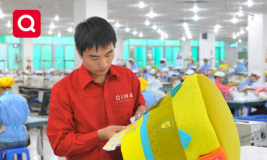EU Toy Safety Directive: New Framework for Evolving Standards
When you commit to bringing a toy to market, you are doing more than selling a product. You are entering into an agreement with the consumers--specifically parents--and guaranteeing that your product will contribute to a child’s playtime and development, and that it has been tested against every applicable standard for safety.
The European Union’s Toy Safety Directive EN 71 outlines the safety criteria your product must meet before it can be sold in any EU market. The main purpose of these criteria is to protect the health and safety of children, parents and caregivers.
In particular, the Directive covers health and safety aspects, such as physical, mechanical, electrical and chemical risks, along with flammability potential, durability, small parts restrictions, and age appropriate labelling.
Adopted in 2008 as part of the EU’s New Legislative Framework, it is one of several new directives aimed at bringing safer, higher-quality products to the market through the use of clearer guidelines for conformity assessment, lab accreditation rules, and CE marking prominence.
Along with the new EU conformance assessment framework comes new data concerning previously unknown connections between certain product substances and their ill-effects on human health and the environment.
Since its adoption, EN 71 has been organized into 14 categories based on toy type and safety concern. These categories include:
- EN 71-1: Mechanical and physical properties
- EN 71-2: Flammability
- EN 71-3: Specification for migration of certain elements
- EN 71-1: Mechanical and physical properties
- EN 72-14: Trampolines
Additional EC directives are applied to all toys as tests for substances like phthalates, lead and cadmium.
Evolving Standards
There is a real advantage to organizing these standards into such specific categories, because it provides industry experts further opportunity to update their given category with product-focused precision.
This year, an amendment was added to EN 71-7 for finger paint safety, requiring greater detail to labelling texts, like Hazardous and Precautionary phrase information concerning potentially dangerous finger paint mixtures.
Several preservatives, such as the carcinogenic paraformaldehyde, have also been banned from use in finger paints and replaced with healthier alternatives including butylparaben and propylparaben, both considered safe for consumer use by the European Union Scientific Committee on Consumer Safety.
Matching Your Standards With Testing Expertise
As a toy manufacturer or importer, staying current with regulation amendments such as EN 71-7:2014+A1:2017, along with new research into child development, manufacturing innovations and chemical data, will foster new design and production ideas for safer toys and children’s equipment.
Partnering with a Laboratory Testing and Inspection service will further help you put those ideas to work. QIMA's Quality Assurance program can assist you through critical design decisions and ensure that your design fits all applicable national and international safety standards.
Once design work is done, QIMA's full-spectrum Product Inspection services will keep a crucial eye on your factory line, from first bell to pre-shipment, because maintaining consistent quality requires constant monitoring.
Let QIMA help you deliver that enriching playtime experience to children by adhering to an uncompromising, safety-first approach to design and manufacturing.
Easily Schedule Your Toy Tests Online
Our online platform and mobile application make it easy for you to schedule Toys and Recreational Item testing, and receive your results at any time. Book new tests, view pending orders, and access results from your mobile device. Our online platform provides valuable supply chain insights, including a summary of your QC activity, all of your supplier’s quality stats, industry benchmarking data, and more.
Get Started: Login or Create Your Account

 Xem Demo
Xem Demo
